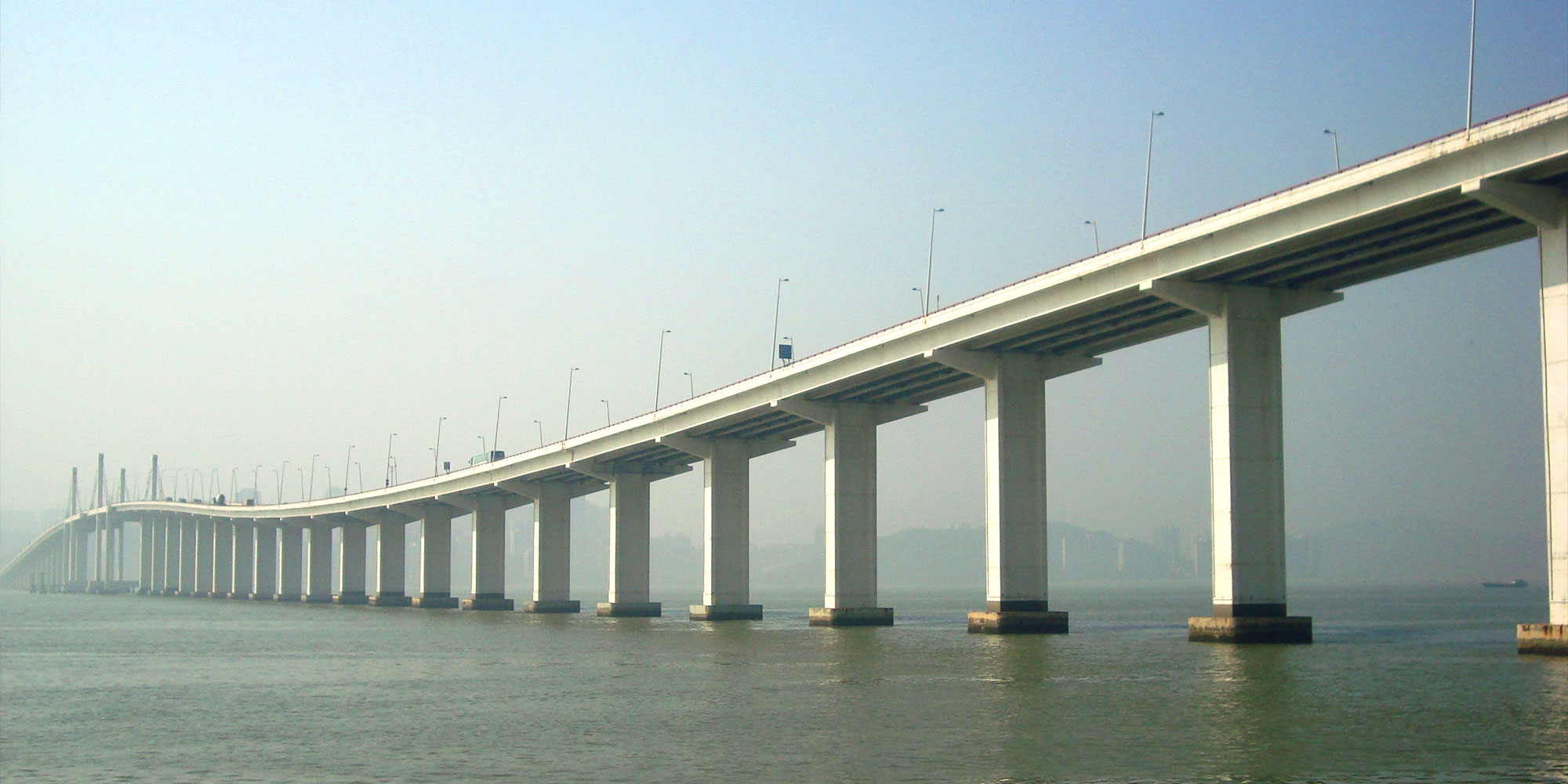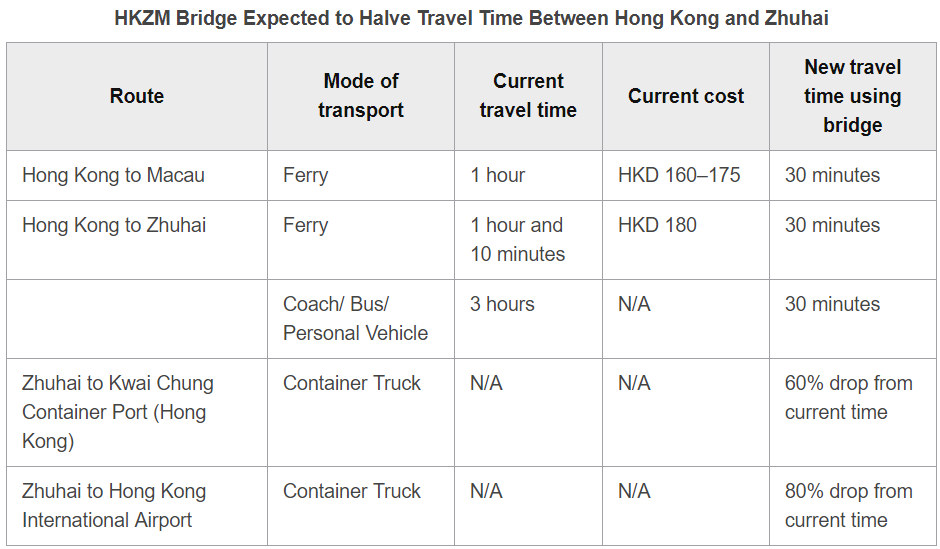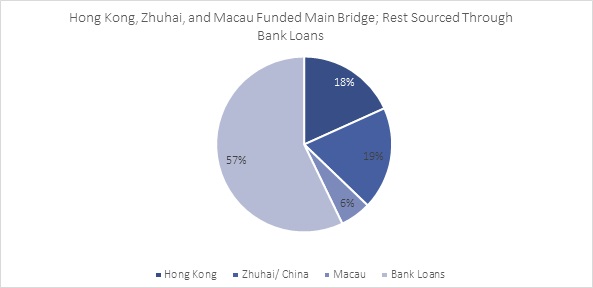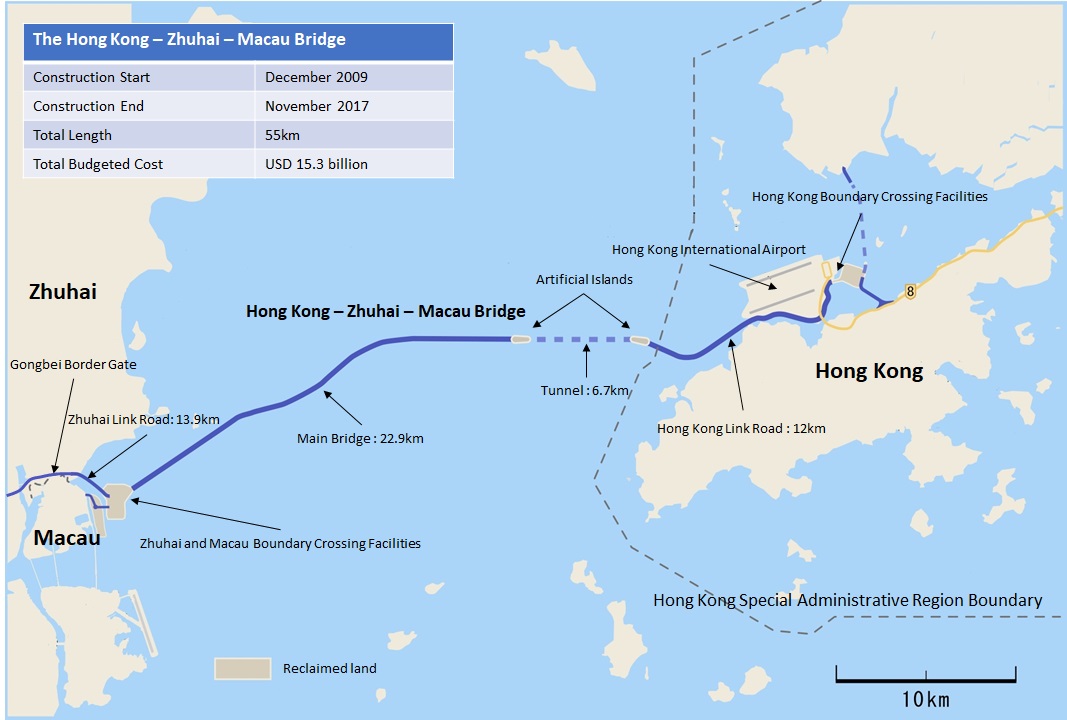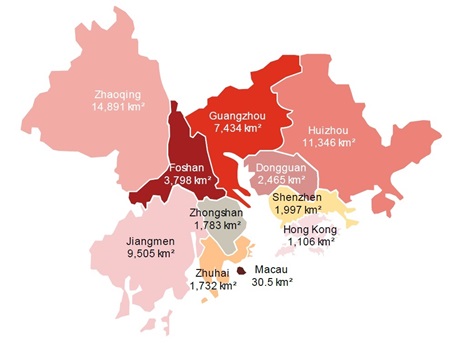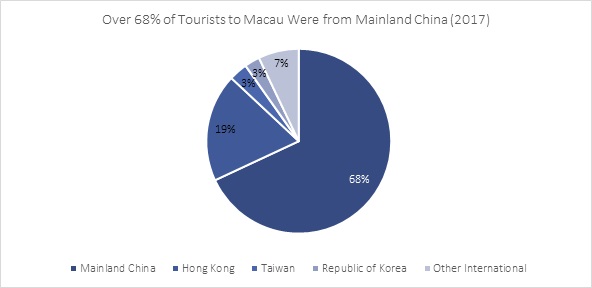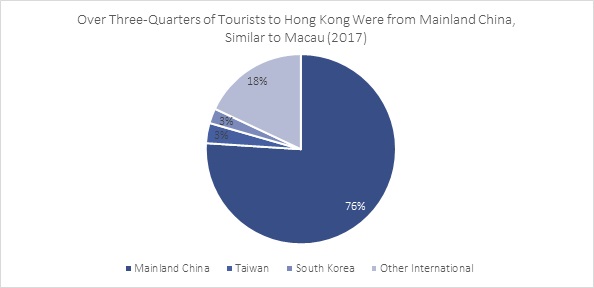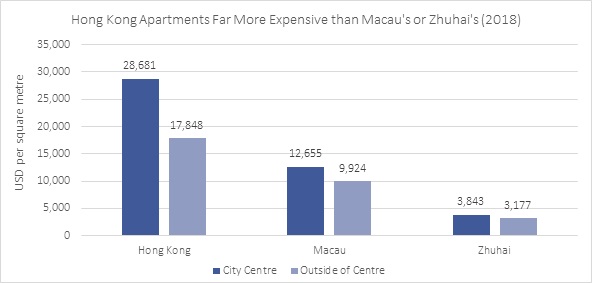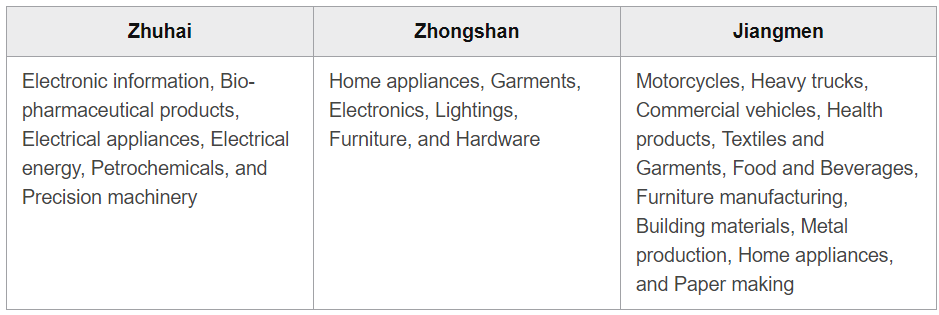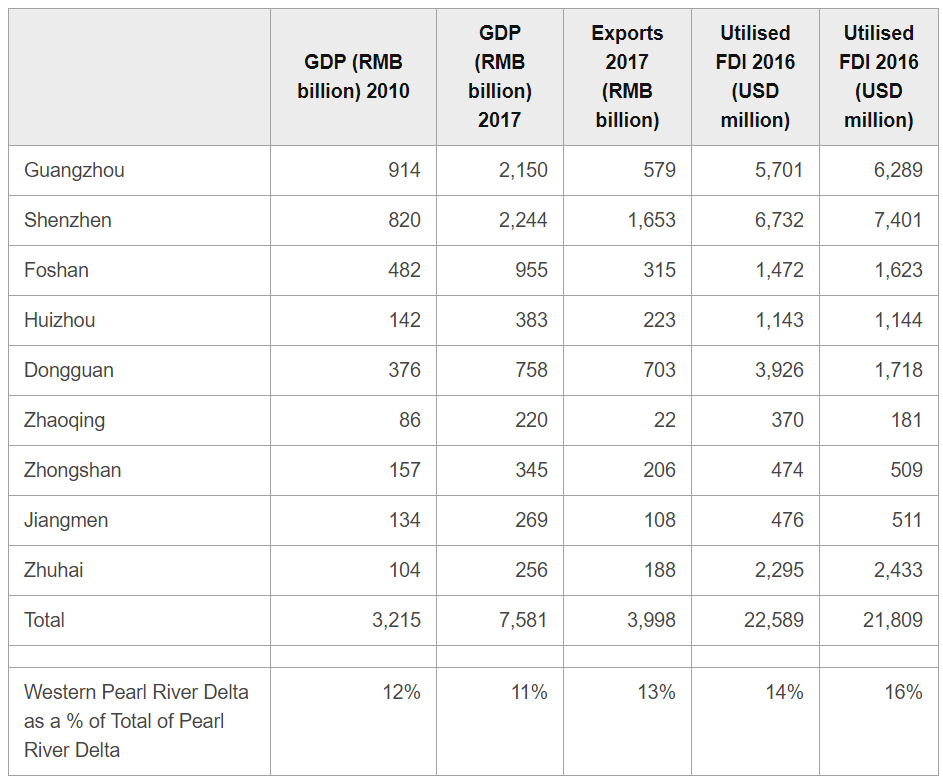Hong Kong-Zhuhai-Macau Bridge: On Strange Tides
|
China’s Hong Kong-Zhuhai-Macau Bridge is the longest cross-sea bridges in the world and has drawn media attention due to its large scale and its potential impact on China’s Greater Bay Area. Budgeted at over USD 15 billion, the bridge is a key step in China’s master plan to transform the Greater Bay Area into a hub for advanced manufacturing and technological innovation, on a par with Tokyo, New York, and San Francisco. |
|
China intends to achieve this by facilitating close connectivity between the cities of the Greater Bay Area and by improving the flow of economic value across the region. |
|
The movement of passengers and cargo across the bridge is expected to impact the tourism and logistics industries in the region. The bridge should also provide people the opportunity to relocate from Hong Kong to Zhuhai (or a nearby city) at a time property prices and congestion on the island are both rising. However, numerous challenges remain on the path to realising the bridge’s full potential. Poorly streamlined border controls raise concerns about wastage of expected cuts in travel time between Hong Kong and Zhuhai. Moreover, the limited issuance of permits restricts private vehicles from the bridge, leading to a loss of the convenience value expected from it. |
|
We feel the Hong Kong-Zhuhai-Macau Bridge will have the most impact on the gambling and tourism industries of Macau and the logistics industry of the region, especially between Hong Kong and Zhuhai, Zhongshan, and Jiangmen, although the short-term impact has not been as strong as expected from an investment of its size. |
|
The bridge’s opening to traffic was recently delayed from the previously scheduled date of 1 July 2018, with little insight from China’s central government on the reasons. |
|
The Hong Kong-Zhuhai-Macau Bridge (HKZM Bridge) is a central part of China’s ambitious plan to make the Greater Bay Area a leading economic driver. China expects the Greater Bay Area to overtake other bay areas around the world in terms of economic output by 2030, e.g. the Greater Tokyo Area, the New York Metropolitan Area, and the San Francisco Bay Area. |
|
China’s Greater Bay Area Competes Closely with Other Key Bay Areas in the World (2016) |
|
|
|
Source: Bloomberg based on Morgan Stanley data |
|
HKZM Bridge Expected to Halve Travel Time Between Hong Kong and Zhuhai |
|
|
|
Source: Source: Compiled by UZABASE based on various materials |
|
HKZM Bridge; The Longest Cross-Sea Bridge in the World |
|
The HKZM Bridge is the longest bridge-cum-tunnel sea crossings in the world. The bridge is said to be able to withstand a magnitude eight earthquake, a super-typhoon, and strikes by super-sized cargo vessels. It contains nearly 4.5 times the amount of steel used in San Francisco’s Golden Gate Bridge. |
|
According to the Hong Kong-Zhuhai-Macao Bridge Authority, the total cost of the main bridge spanning 22.9 kilometres (km) was USD 7.6 billion. Of this, USD 4.3 billion was funded through bank loans and the remaining USD 3.2 billion by Hong Kong (USD 1.4 billion), Zhuhai (USD 1.4 billion), and Macau (USD 0.4 billion). CNN, citing a spokesman at Hong Kong’s Transport and Housing Bureau, stated that Hong Kong spent an additional USD 4.6 billion on its boundary crossing facilities and USD 3.2 billion on a road to link the main bridge and the boundary crossing, bringing Hong Kong’s total contribution to over USD 9 billion. In total all three cities had spent close to USD 15.4 billion on the bridge. The bank loan was facilitated by Bank of China and is expected to be repaid by the Hong Kong-Zhuhai-Macao Bridge Authority with the income generated from the bridge. |
|
|
|
Source: Hong Kong-Zhuhai-Macau Bridge Authority |
|
HKZM Bridge (Length: 55 Km) to Comprise Two Man-Made Islands and Tunnel Stretching Nearly 7 Km |
|
|
|
Source: Recreated by UZABASE based on multiple sources |
|
The official website for the HKZM Bridge states the importance of economically integrating Hong Kong, Macau, and the western Pearl River Delta region, amongst other benefits. The western Pearl River Delta region will be within a three-hour commuting radius from Hong Kong; this should attract more external investments, especially from investors based in Hong Kong. |
|
Greater Bay Area; Expected to Become a Hub for Advanced Manufacturing and Innovation |
|
China’s Greater Bay Area is located in Southern China and comprises Hong Kong, Macau, and the Pearl River Delta. It covers 56,500 square kilometres (sq km) and has a population of around 68 million people. The region already plays a key role in China’s economy due to its strong manufacturing base. Although the Greater Bay Area covers only about 1% of China’s total land area and accounts for only about 5% of the country’s population, it contributed nearly 12% of China’s GDP in 2017. |
|
Although Only 1% of China’s Land Area, Greater Bay Area Contributed Nearly 12% of China’s GDP in 2017 |
|
|
|
Source: PricewaterhouseCoopers based on Municipal Bureau of Statistics |
|
Hong Kong and Macau More Service Oriented; Other Cities Have Strong Manufacturing Base |
|
Major Economic Indicators of Guangdong-Hong Kong-Macau Bay Area (2017) |
|
|
|
Source: http://hong-kong-economy-research.hktdc.com |
|
China plans to make the Greater Bay Area a hub for advanced manufacturing, innovation, finance, shipping, and trade, moving away from its current manufacturing base. One of the key challenges in transforming the super-cities of the Greater Bay Area into city clusters is the establishment of better connectivity amongst them. China aims to address this through three main infrastructure projects: 1) the HKZM Bridge, 2) the Guangzhou-Shenzhen-Hong Kong express rail link, and 3) a sea tunnel linking Shenzhen, Dongguan, Huizhou, Zhuhai, Zhongshan, and Jiangmen. The express rail link is expected to be completed by the third quarter of 2018; it should cut down travel time between Guangzhou and Hong Kong to 48 minutes and between Shenzhen and Hong Kong to 14 minutes. The sea tunnel is currently under construction. Less prominent projects include the Human Bridge II connecting Guangzhou and Dongguan (expected to open to traffic in 2019). |
|
In the sections that follow, we identify the main industries the opening of the bridge to traffic is likely to impact. |
|
HKZM Bridge a Positive for Macau’s Gaming and Tourism Industries, but No Game Changer |
|
The HKZM Bridge is expected to play a key role in Macau’s gaming and tourism industries, as it will directly link Macau to Hong Kong, which also sees significant tourist arrivals. Macau’s economy depends heavily on these two industries: in 2015 (latest data available), their combined contribution to Macau’s GDP was around 48%. Macau is home to the world’s biggest gaming market; in 2016, it earned more than four times the revenue of Las Vegas. Macau gaming market broadly have two segments; (1) high net-worth individuals gambling on high volumes (VIP market; contributed close to 57% of gross gaming revenue in 2017) and (2) visitors (mainly from Mainland China) who’s purpose of visit is leisure and casual gaming (Mass Market; close to 43% contribution in 2017). The HKZM bridge is likely to help the growth of the Mass market segment. In 2017, Macau attracted 32.6 million tourists, of which 68.1% were from Mainland China and 19.0% from Hong Kong. We believe the HKZM Bridge is likely to attract more international tourists visiting Hong Kong to Macau, as the journey to Macau will be more convenient as well as easy to fit into their agendas, considering the reduced travel time. Further, given the overcrowding at the Macau Airport, the bridge should provide an alternative for tourists; they will be able to fly to Hong Kong and then reach Macau via the bridge. Macau Airport should continue to show a high utilisation rate of 95.2% in 2018E (based on passenger movement in 2017: 7.14 million), despite the completion of its expansion project, which is set to increase airport capacity to 7.5 million passengers in 2018E. |
|
|
|
Source: www.dataplus.macaotourism.gov.mo |
|
|
|
Source: www.dataplus.macaotourism.gov.mo |
|
Hong Kong, on the other hand, is a more saturated tourist market than Macau. In 2017, Hong Kong was the city that saw the most tourist arrivals in the world (58.4 million, 76.0% of whom were from Mainland China). |
|
|
|
Source: www.discoverhongkong.com |
|
Once the HKZM Bridge opens, tourists will have the option to either take a bus or a coach to travel between Macau and Hong Kong. According to the South China Morning Post, buses will charge a fare of HKD 80 between Hong Kong and Zhuhai, while coaches will charge around HKD 130, less than the current average of HKD 220 for the ferry between Hong Kong and Macau. Bus and coach charges are based on a tentative toll of HKD 540 (RMB 450). |
|
Whilst the benefits from the bridge to Macau Tourism is sound on principle, the near to medium term positive impact is likely to be low in our belief. Macau’s Transport Bureau confirmed in a written reply to questions from GGRAsia that Macau’s casino shuttle busses will not be allowed to cross the bridge (this was despite discussions with casino operators about the possibility of a joint shuttle service from the bridge’s Macau boundary crossing point to the city, with multiple stops). Furthermore, although travel time is expected to halve to 30 minutes from its current 1 hour (via ferry/turbojet), immigration checks at the bridge’s entrances are expected to lengthen the journey to 45 minutes to an hour. |
|
In June 2018, China’s Transport and Housing Bureau cut its traffic estimates for the bridge from its previous estimates of 33,000 vehicles and 171,000 passengers in 2030E by close to 12% and 26% to 29,000 vehicles and 126,000 passengers respectively. It cited as reasons an increase in competition from the Shenzhen-Zhongshan bridge, the rapid redevelopment of mainland railways, and a decrease in cross-boundary land freight transport. Based on these estimates, we believe the bridge’s impact on the tourism industry will not be as significant as expected. |
|
Real Estate Prices Rise in Macau and Hengqin, Driven by Improved Connectivity to Hong Kong |
|
With house prices rising steeply in Hong Kong, the new HKZM Bridge could provide an alternative for people working in Hong Kong to reside in nearby cities instead and to travel to work. According to Numbeo (an online site that compiles real estate transaction data), in June 2018, the average sales price of a Hong Kong apartment in the city centre was around USD 28,681 per square metre; in comparison, an apartment in neighbouring Macau was USD 12,655 per square metre, and in Zhuhai it was USD 3,843. Considering the drastically different real estate prices, some residents employed in Hong Kong are likely to consider moving to cheaper cities once they have the convenience of the HKZM Bridge. |
|
|
|
Source: Numbeo |
|
|
|
Source: Numbeo |
|
The HKZM Bridge has driven up commercial property prices in Macau (unlike residential property there) and in the neighbouring Hengqin Island (which is part of Mainland China), as the two cities are expected to be the centre for tourism for meetings, incentives, conferencing, and exhibitions (MICE tourism). In 2017, the number of properties sold in Hengqin rose 154.9% YoY, with property transactions in the port area forming close to 47% of the total. According to Centaline Property’s statistics, 32.3% of buyers were Macau residents, 18.8% Zhuhai residents, and 18.0% Hong Kong residents. |
|
However, relocation to nearby Zhuhai is considered a challenge for a number of reasons. According to a survey conducted by the Hong Kong Institute of Asia-Pacific Studies at the Chinese University, 703 participants (35.0% of the total surveyed) agreed that it would be feasible to live in Macau while working in Hong Kong, whereas only 28.3% said it would be feasible to live in Zhuhai while working in Hong Kong. Although the HKZM Bridge creates a link to Hong Kong, the commute might not be as convenient as expected. A one-way bus trip from Zhuhai to Hong Kong is expected to cost HKD 80, and the travel time is expected take more than an hour with the immigration checks. Furthermore, the bus will go only up to the border post, from where passengers will have to take another bus or a taxi to reach their destinations. Public transportation as of now is the only possible mode of travel, as the entrances of the bridge are restricted by permits (of which only a limited number will be issued by each city). Macau is expected to issue 600 permits, with 300 of these allocated for individuals and the remaining 300 for Macau-registered companies. Hong Kong is expected to issue a further 300 permits to individuals and companies based in Hong Kong. |
|
Apart from the challenges related to commuting between Zhuhai and Hong Kong, there are restrictions against non-residents’ purchase of property in Zhuhai. The Zhuhai local government demands that a buyer show five years of tax receipts or social insurance payments in the city; this leaves renting an apartment the only option. Despite apartments can be purchased in the neighbouring city Zhongshan, it is too far for daily commuting. Furthermore, among those considering relocating to Zhuhai, families with children should face difficulties finding schools: parents who do not have Zhuhai registration cannot enter children into a city government school, and must instead consider private schools. Private schools, which run classes in Mandarin or English, tend to charge higher fees. Zhuhai schools’ curriculums are closer to Mainland China’s than to Hong Kong’s, and this might be another concern for parents. |
|
Logistics Industry Expected to Benefit; Investment in Manufacturing Industry Muted |
|
Once the HKZM Bridge opens to traffic, the direct link established to the Hong Kong International Airport and Zhuhai is expected to improve the logistics industry not only in the western Pearl River Delta cities of Zhuhai, Zhongshan, and Jiangmen, but also in the nearby cities of Zhongshan, Jiangmen, and Yangjiang. The Hong Kong International Airport handled the highest amount of cargo by weight globally for the seventh consecutive year in 2016: a total of over 4.52 million tonnes. Industries in Zhuhai, Zhongshan, and Jiangmen are expected to benefit from the reduction in transport time to the Hong Kong International Airport to 45 minutes from the current 4 hours. This should be a positive for the transport of high-value items that require urgent dispatch, such as fresh food, flowers, electronic goods, and pharmaceuticals. Of the volume of cargo handled by the Hong Kong International Airport in 2016, 10% translated into 40% of the value. |
|
Most Industries in the Three Cities Produce High-Value Items and Should Benefit from Faster Dispatch of Goods |
|
|
|
Source: HKTDC Research based on Guangdong Statistical Yearbook 2017 |
|
The western Pearl River Delta region is investing in the development of modern high-tech industries, smart manufacturing, and high-end manufacturing, in line with industry trends in the rest of the Pearl River Delta. |
|
To facilitate the expected increase in trade due to the HKZM Bridge, both Hong Kong and Zhuhai have made significant investments in the logistics industry. In April 2018, Hong Kong’s Development Bureau tendered a 340,870 square-foot site in Tuen Mun for a five-storey logistics centre with a gross floor area of 852,000 square feet. It will be connected to the HKZM Bridge, which will link the manufacturing hubs in the western Pearl River Delta to the Hong Kong International Airport. On the mainland, Zhuhai has planned the Zhuhai-Hong Kong-Macau Cooperative Logistics Park on a 800,000 square metre lot. This will be the transit point for import and export goods that will be distributed to western Guangdong and beyond. |
|
However, in a June 2018 post in the Macau Business, The Director of the Macau International Logistics and Forwarding Association, Victor Lei Kuok Fai, said the logistics industry in Macau has no intention of collaborating with the Chinese side, despite the opening of the HKZM Bridge. He stated that the industry has already been marginalised, given that no details pertaining to logistics had been announced. |
|
Investment in the manufacturing base of the western Pearl River Delta is not as high as expected, despite the hype about growth in trade between the two cities. Since construction began on the HKZM Bridge in 2009, FDI inflows to cities in the western Pearl River Delta have been consistent with the rest of the cities’. GDP as a percentage of the region’s has stayed at around 12% over 2010–16, showing no sign of growth in the manufacturing base beyond the rest of the region. FDI to the three cities in the western Pearl River Delta increased 6.4% YoY to USD 3.4 billion in 2017, i.e. only close to 16% of total FDI inflows to the region versus 14% in 2016. Although the majority (46–57%) of FDIs originate from Hong Kong and Macau and are directed towards the manufacturing industry, it is highly unlikely that cities in the western Pearl River Delta will see a significant breakthrough in economic growth due to the HKZM Bridge, compared with the other cities in the region. Most of the cities in the region are either economic or technological development zones and are driven mainly by FDI flows. |
|
Increase in FDI Inflow Not Significant Enough to Impact Economy of Western Pearl River Delta |
|
|
|
Source: HKTDC Research based on Guangdong Statistical Yearbook 2017 |
|
Budget Overruns and Continues Delays Hamper the Opening of the Bridge |
|
The opening of the HKZM Bridge has been delayed from its original date of 1 July 2018. As of 8 July 2018, there were no statements from China’s central government on the delay or the expected date of opening. Media reports speculate that the reason for the delay is the recent discovery of multiple shortfalls in the design of the bridge. The South China Morning Post, citing engineering experts, said the following design flaw in the bridge could put workers’ lives at risk: the transformer room and the switch room are located in the basement of the passenger clearance building on the artificial islands and are therefore prone to water seepage. The probable solution of moving both rooms to the ground floor is expected to take at least 3–4 months, which could push the opening of the bridge to 2019. According to the same news source, in a court hearing in June 2018, it was revealed that technicians under the Hong Kong government contractor faked reports on the strength of concrete bricks used in the bridge, as they were pressed for time and faced a manpower shortage. The defendants admitted the brick tests were faked between September 2012 and July 2016; a total of 19 people were charged. |
|
The construction of the HKZM Bridge has been delayed in few instances previously due to budget overruns, accidents and even cyber-attacks; and the opening of the bridge to traffic was delayed from the original October 2016 opening to the second half of 2018. |
